Pew Research Center
September 27, 2006
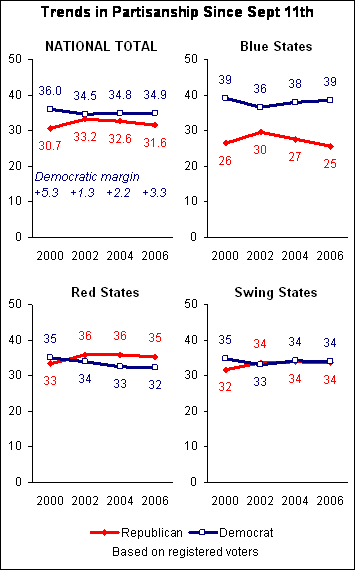 Following the Sept. 11 terrorist attacks, the Republican Party made
sharp gains in party affiliation nationally, nearly wiping out the Democrats'
long-standing advantage. However, the Republican increases have faded and the
Democratic Party now holds a slim edge in overall partisanship among registered
voters. The modest Democratic recovery has been mostly concentrated in the blue
states that were already firmly in the Democratic camp, and the party has not
made inroads in either politically contested swing states or in Republican red
states. But the Democrats have gained ground among independent voters, who now
lean more Democratic than in 2004.
Following the Sept. 11 terrorist attacks, the Republican Party made
sharp gains in party affiliation nationally, nearly wiping out the Democrats'
long-standing advantage. However, the Republican increases have faded and the
Democratic Party now holds a slim edge in overall partisanship among registered
voters. The modest Democratic recovery has been mostly concentrated in the blue
states that were already firmly in the Democratic camp, and the party has not
made inroads in either politically contested swing states or in Republican red
states. But the Democrats have gained ground among independent voters, who now
lean more Democratic than in 2004.
In nearly 20,000 interviews conducted by the Pew Research Center over the past year, 34.9% of registered voters identify themselves as Democrats, 33.5% as independents, and 31.6% as Republicans. That represents a widening Democratic lead compared with election-year averages in 2004 and 2002, due mostly to a gradual decline in the number of voters who identify themselves as Republicans. However, the Democratic Party's lead remains much smaller than it was in 2000, the final year of Bill Clinton's presidency (36.0% Democrat, 33.3% independent, 30.7% Republican).
More important, while the Democratic Party has widened its lead considerably over the past four years among the group of blue states, it has gained little ground elsewhere. Currently, 39% of registered voters in blue states, taken together, identify themselves as Democrats, compared with 36% as independents, and just 25% as Republicans. In 2002, the GOP had sliced the Democratic in lead in blue states to six points, reflecting the generally favorable climate for Republicans in the aftermath of the Sept. 11 terrorist attacks.
However, the Republicans currently hold a small but consistent edge over the Democrats in political red states (35% Republican, 33% independent, 32% Democrat). And as a group, swing states remain evenly divided politically - 34% identify themselves as Democrats, the same number as Republicans and 32% as independents. In 2000 these states tilted Democratic (35% vs. 32% Republican).
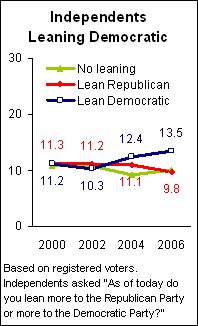 Pew's analysis of long-term trends in party affiliation also shows
that independents "lean" more Democratic than in the past. Roughly a third of
voters identify with neither party; among this group, 13.5% say they lean
Democratic, compared with 9.8% who say they lean Republican, while 10.2% refuse
to lean to either party. By comparison, at least as many independents leaned
Republican (11.2%) as leaned Democratic (10.3%) in the 2002 election cycle.
This has potential implications in this year's midterm election campaign, where
independents show a decided preference for the Democratic candidate.
Pew's analysis of long-term trends in party affiliation also shows
that independents "lean" more Democratic than in the past. Roughly a third of
voters identify with neither party; among this group, 13.5% say they lean
Democratic, compared with 9.8% who say they lean Republican, while 10.2% refuse
to lean to either party. By comparison, at least as many independents leaned
Republican (11.2%) as leaned Democratic (10.3%) in the 2002 election cycle.
This has potential implications in this year's midterm election campaign, where
independents show a decided preference for the Democratic candidate.
In surveys conducted in August and September, the Democrats held a 48%-30% advantage among independent voters in the generic ballot, which is a major factor in the Democrats' 11-point lead in the midterm horserace (50%-39%). In the fall of 2002, the Democrats led by only six points among independent voters (41%-35%). However, independents are much less likely than committed partisans to actually vote on Election Day, and this is especially the case in midterm elections.
Regions: West Coast Bluer, Deep South Redder
Beyond the national trends in party affiliation, there have been significant shifts at the regional and state levels. Notably, the GOP's post-9/11 gains in West Coast states have all but disappeared. In 2002, Democrats led by only three points in this group of states; this year, 39% of voters in these states, taken together, identify themselves as Democrats, compared with 33% as independents and 28% as Republicans. The Democrats' advantage in this group of states is now about the same as it was in 2000 (10% then, 11% now).
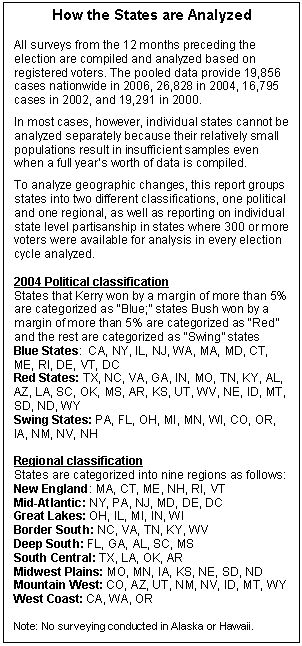 Moreover, the Democratic Party has increased its already sizable
lead in the New England states. Nearly twice as many voters in this group of
states identify themselves as Democrats than Republicans (34% vs. 18%). In
2000, when the Democratic Party maintained a larger advantage in party
identification nationally, it only led by seven points over the Republican
Party in this group of states. Democrats have also recovered from Republican
gains in the Midwest Plains states - currently there are roughly an equal
number of Democrats and Republicans here (32% vs. 33%), where Republicans had
held a seven-point advantage in 2002.
Moreover, the Democratic Party has increased its already sizable
lead in the New England states. Nearly twice as many voters in this group of
states identify themselves as Democrats than Republicans (34% vs. 18%). In
2000, when the Democratic Party maintained a larger advantage in party
identification nationally, it only led by seven points over the Republican
Party in this group of states. Democrats have also recovered from Republican
gains in the Midwest Plains states - currently there are roughly an equal
number of Democrats and Republicans here (32% vs. 33%), where Republicans had
held a seven-point advantage in 2002.
At the same time, the Republican Party has consolidated its post-9/11 gains in the states of the deep South. In 2000, the Democrats led by six points in this group of states, but two years later the GOP took a three-point lead. In 2004, 35% of voters in the deep South identified themselves as Democrats, and the same number as Republicans. But this year, the GOP again has a three-point lead over the Democrats (36%-33%).
Similarly, the Republican Party has narrowed the Democratic Party's advantage in the border states, which include North Carolina, Virginia, Tennessee, Kentucky and West Virginia. Currently, 36% of voters in these states - taken together - identify as Democrats, while 33% say they are Republicans. In 2002, the Democrats held a five-point lead in this group of states; two years earlier, the Democrats' advantage was eight points.
The GOP also has cut into the Democrats' lead in Great Lake states, which include Ohio, Illinois, Michigan, Indiana, and Wisconsin. Currently, voters are almost evenly divided in these states - 35% are independents, 33% are Democrats, and 32% are Republicans. Six years ago, Democrats led by four points in these states, taken as a group.
Republicans continue to hold a wider advantage in the Mountain West than in any other region. But the stability of party identification in the region as a whole belies notable Democratic gains and Republican gains in individual states.
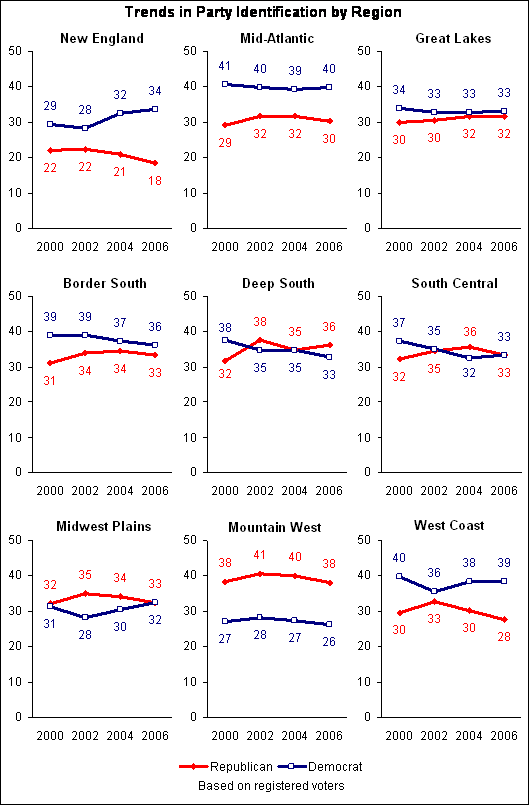
States Where Democrats Have Recovered
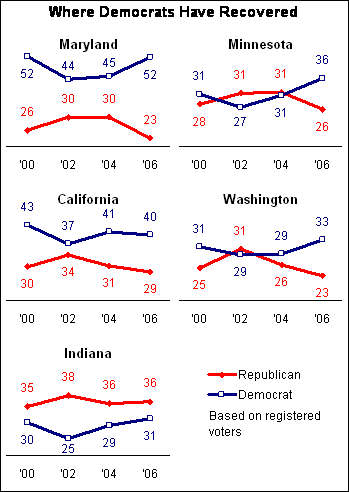 While Democratic fortunes have improved in the years since the Sept.
11 terrorist attacks, the revival has been particularly notable in a handful of
states - some of which have been traditional Democratic strongholds. The
percentage of Maryland voters who identify themselves as Democrats fell from
52% in 2000 to just 44% during the 2002 election cycle, but has rebounded back
to 52% in the current year. Similarly in the West, Democrats held sizable
advantages in both California and Washington that largely disappeared in the
wake of the Sept. 11 attacks, but have rebounded to previous levels since that
time. And while the Democrats lost a small identification edge among registered
voters in Minnesota in the year following the terrorist attacks, they have
reopened a 10-point lead there today.
While Democratic fortunes have improved in the years since the Sept.
11 terrorist attacks, the revival has been particularly notable in a handful of
states - some of which have been traditional Democratic strongholds. The
percentage of Maryland voters who identify themselves as Democrats fell from
52% in 2000 to just 44% during the 2002 election cycle, but has rebounded back
to 52% in the current year. Similarly in the West, Democrats held sizable
advantages in both California and Washington that largely disappeared in the
wake of the Sept. 11 attacks, but have rebounded to previous levels since that
time. And while the Democrats lost a small identification edge among registered
voters in Minnesota in the year following the terrorist attacks, they have
reopened a 10-point lead there today.
Some of the Democratic rebound has happened in parts of the country that are not traditional party strongholds. Indiana is an example of a Republican-leaning state where Democrats suffered further losses in 2002. But the current five-point Republican edge in party affiliation is considerably smaller than the 13-point lead the party held in 2002, and much closer to the pre-9/11 statewide balance.
States Where GOP Gains Have Held
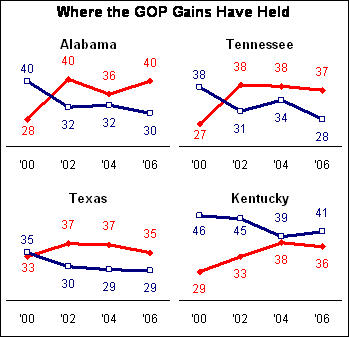 In other parts of the country, Democratic identification shows no
signs of recovering in the years since Sept. 11. Notably, sizable Democratic
advantages in states such as Alabama and Tennessee in the 2000 election cycle
reversed themselves in the wake of the attacks, and Democratic identification
has only slid further in the years since. In both states, Democratic
identification has fallen by ten points since 2000, while Republicans have
gained by roughly the same amount.
In other parts of the country, Democratic identification shows no
signs of recovering in the years since Sept. 11. Notably, sizable Democratic
advantages in states such as Alabama and Tennessee in the 2000 election cycle
reversed themselves in the wake of the attacks, and Democratic identification
has only slid further in the years since. In both states, Democratic
identification has fallen by ten points since 2000, while Republicans have
gained by roughly the same amount.
Texas was nearly evenly split during the 2000 election cycle, but has maintained a decided Republican advantage in every year since. Many other GOP leaning states, such as Utah, Idaho, Nebraska, and Kansas show similar patterns, though too few cases are available in the Pew database to analyze these states individually.
Democratic fortunes in Kentucky have also suffered in recent years. While there are still more Democrats than Republicans in the state, the gap has narrowed substantially throughout the past six years, as Republican identification has risen from 29% to 36% among Kentucky voters, while Democratic identification has slipped from 46% to 41%.
Other States: A Mixed Pattern
Democrats continue to hold a sizable lead in some large and heavily urban states. The Democratic Party's advantage narrowed slightly in both Illinois and Massachusetts in the year after the Sept. 11 attacks, but has since recovered. The Democrats' position has improved substantially in New Jersey, where it now holds a 12-point (39% to 27%) identification advantage. But in neighboring New York the pattern is the reverse, as Democratic Party identification has slipped five points, from 42% to 37% since 2000. However, there have been no commensurate GOP gains in the Empire State, and Democrats continue to hold a ten-point advantage in party identification.
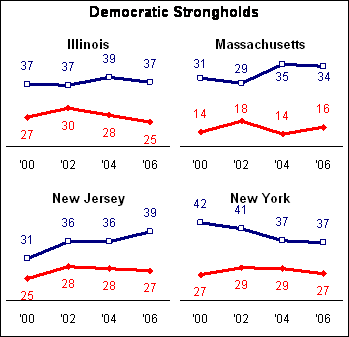
The 12 swing states, which collectively were divided in their vote in the last presidential election, are also divided in their partisan leaning. This is also the case when some of the larger swing states are analyzed individually, and the partisan balance has been largely unmoved in recent years. In Pennsylvania, Michigan, Ohio and Wisconsin, there was no fundamental shift in the political landscape following the Sept. 11 terrorist attacks, and there has been little shift in the ensuing years.
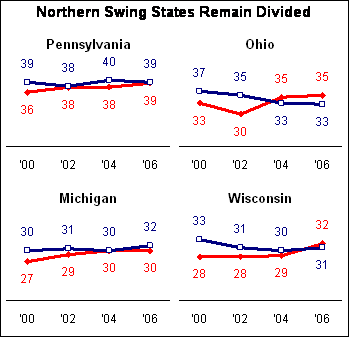
By contrast, partisan attachments in another key swing state - Florida - have been notably unstable in recent years. The GOP made significant gains in Florida in the year after Sept. 11 - a 10-point Democratic identification advantage in 2000 flipped to a five-point GOP edge in the 2002 midterm. But these gains have since subsided, and in both 2004 and 2006 neither party has held an identification advantage in this critical swing state.
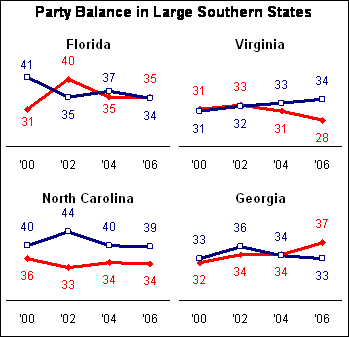
Other large Southern states have also recorded only modest partisan shifts recently. While Democratic Party identification has risen slightly in Virginia, neither this change nor the small drop in GOP affiliation is statistically significant. In every recent election cycle, more North Carolinians have identified as Democrats than Republicans, and the party's lead is about the same as it was in 2000. Meanwhile, in Georgia the GOP has made some advances, with a gradual five-point increase in Republican identification over the past four election cycles. But Democratic identification has remained largely unchanged and neither party has a clear edge.
Pockets of Support for Bush
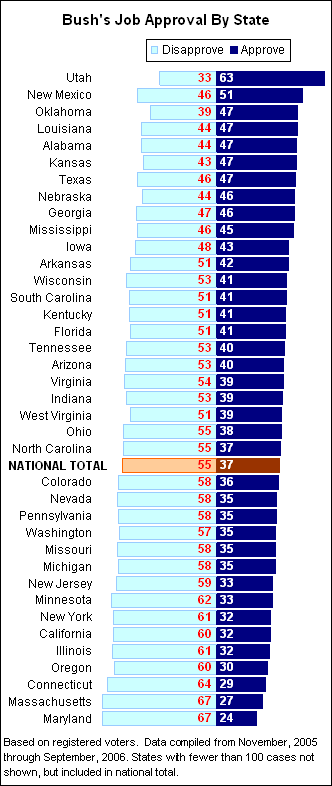 While overall approval of President Bush's job performance has
tumbled over the past year, he may still prove to be effective on the campaign
stump for Republican candidates in certain parts of the country. In Pew
Research Center surveys conducted over the past year, an average of 37% of
Americans register approval of the job George W. Bush is doing as president,
while 55% disapprove. But the president has significant pockets of support in
certain areas, particularly in the South and Mountain West. Voters in Utah, in
particular, remain strongly behind the president - over the past year, 63%
approve of his job performance. Similarly, in New Mexico, Oklahoma, Louisiana,
Alabama and Kansas more voters surveyed in the past year approve rather than
disapprove.
While overall approval of President Bush's job performance has
tumbled over the past year, he may still prove to be effective on the campaign
stump for Republican candidates in certain parts of the country. In Pew
Research Center surveys conducted over the past year, an average of 37% of
Americans register approval of the job George W. Bush is doing as president,
while 55% disapprove. But the president has significant pockets of support in
certain areas, particularly in the South and Mountain West. Voters in Utah, in
particular, remain strongly behind the president - over the past year, 63%
approve of his job performance. Similarly, in New Mexico, Oklahoma, Louisiana,
Alabama and Kansas more voters surveyed in the past year approve rather than
disapprove.
Not surprisingly, the president's job ratings are weak in many Democratic- leaning states. Just 24% of Maryland voters interviewed over the past year give Bush favorable marks, while 67% disapprove of his job performance, and the balance of opinion is nearly as bad in Massachusetts and Connecticut. Similarly, more voters in Oregon, Illinois, California and New York disapprove of the president than approve by margins of roughly two-to-one.
Commentary: